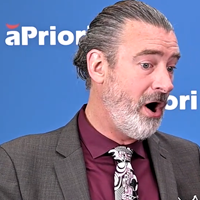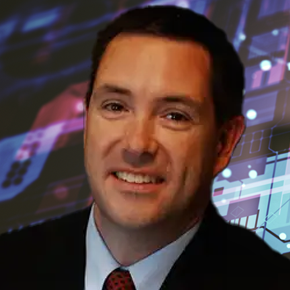February 1, 2024
Peter Zeihan: Is it the End of the World for Manufacturing?

Transcript
Peter Zeihan, Geopolitical Strategist, on the Future of Global Manufacturing
Peter Zeihan brings a unique perspective on how geopolitical risks are re-shaping the world economy, and what that means for global manufacturing. Peter Zeihan is a renowned geopolitical strategist and the author of several influential books, including The Accidental Superpower, The Absent Superpower, and his latest groundbreaking work, The End of the World Is Just the Beginning.
Today, I’m talking with Peter Zeihan about the big questions in manufacturing.
- Should American manufacturers pull out of China?
- Can Europe keep producing in an age of scarce Russian oil?
- What can we expect from rising stars in manufacturing like India and Mexico?
Peter Zeihan tackles all of these questions, plus weighs in on the power transition from baby boomers to millennials, and what this means for the worldview of manufacturers when it comes to labor.
Peter Zeihan rose to international prominence as a vice president of Stratfor, the world’s leading geopolitical intelligence platform. His work has been featured in news outlets like the Wall Street Journal, his books have made to the New York Times bestseller list, and his YouTube channel boasts over half a million subscribers. I spoke to Peter Zeihan at aPriori’s most recent Manufacturing Insights conference, where Peter Zeihan delivered the keynote address on what manufacturers need to do to adapt to geopolitical risks today, and in the years to come. Here is my conversation on the future of global manufacturing with Peter Zeihan.
The End of the World Is Just the Beginning
Leah Archibald: So Peter, your latest bestselling book, The End of the World Is Just the Beginning. End of the world?
Peter Zeihan: End of the world. Well, end of the world we’re in. We’ve been living in the globalized age now for 75 years, and that’s generated a lot of interesting things in agriculture and manufacturing and finance. But it’s all predicated upon a security environment that can’t be sustained anymore, and an economic player in the United States who no longer has an interest in keeping it going. So it’s now starting to fall apart, and it’s going to do so with ever faster degradation, culminating in, probably with the most dramatic impact, is gonna be the end of China within a decade.
Leah Archibald: And when you say everything is falling apart, what you really mean is that there are disparate elements of our international structure that are coming together in a way that you’re seeing and other people aren’t seeing. So the war in Ukraine, the high prices for international shipping, the shortage of labor, you’re saying these are not isolated incidents. These are coming together into a kaleidoscope of catastrophe?
Peter Zeihan: Absolutely. Many things have their roots in globalization. So part of what the Americans did back in the late ’40s and early ’50s, is we tried to convince everybody that your old historical rivalries didn’t matter anymore, because we were going to maintain a global whole for everybody. And that allowed everyone to specialize, everyone to move up the value added supply chain, everybody to industrialize. But that ultimately changed a lot of things. We started having fewer kids. And when you fast forward that 75 years, it’s not that we’re running out of children in most of the world, it’s we’re running out of working aged adults. So simply maintaining the production facilities now is beyond the capacity of a lot of countries and there’s not enough young people to consume it anyway.
The Long Term Labor Crisis
Leah Archibald: You mentioned something very important to the manufacturing sector, which is the supply of labor. So this is something that we’ve been talking about for a few years. There are not enough people to replace the aging boomers out of manufacturing jobs. You are saying it’s not only the manufacturing industry’s problem, and it’s not going to get better for a very long time.
Peter Zeihan: Absolutely. So with globalization and industrialization, as we moved into cities to take those industrial jobs, the birth rates steadily started to fall. And the last really big generation that existed on a global basis were the baby boomers. And they were born between the mid ’60s and the mid ’80s. Well, they’re now retiring en masse. So the largest generation, the largest workforce we’ve ever had is going away. The next generation down that is of size were the millennials. But the millennials are… They don’t have the quality of the generations that have come before.
Leah Archibald: Say what you mean. What do you mean by quality?
Peter Zeihan: So you all know the negative stereotypes about millennials. They’re lazy, narcissistic, took five years off in Europe to find themselves in their 20s. That’s true for half of them. The other half have always done everything we expected. They graduated from college early, they went straight into the workforce, but because of that, they got hit with the Great Recession. They were the last ones in the door so the first ones kicked out. So whether the millennials did everything right or everything wrong, they all lost out on four years on average of work experience in their 20s.
Leah Archibald: And it’s fragmented work experience.
Peter Zeihan: Absolutely.
Leah Archibald: They don’t have the same experience training within a company as the baby boomers had.
Peter Zeihan: Or Gen X. And so, the millennials are the least skilled generation for their age bracket that we’ve ever had. There are a lot of them, and thank God for that. But they don’t have the skillset that is necessary to replace things. And the next generation down that might, the zoomers, is the smallest generation we’ve ever had. And the shortage of zoomers means that we’re going to have an increasing labor shortage each and every year until we have another large generation enter their 20s. It’s not going to happen until 2045. So this is just the environment that we’re in. It’s going to get stricter and stricter and stricter, and there’s no way around that.
Leah Archibald: And that’s happening in the United States, but it’s not just happening in the United States. The population restriction is happening worldwide in a way that also impacts manufacturing.
Peter Zeihan: Absolutely. So American boomers are unique in only one way. They had kids, they had the millennials. The boomer generation, everywhere else in the world, with the exception of New Zealand and France didn’t. So this period of stretch for the next 10 to 25 years that we’re going through, that is a uniquely American issue. Everyone else, it will never get better.
Will Reshoring Manufacturing Help?
Leah Archibald: Now, we have in the past 10 years solved some of the later shortage problems by offshoring, by buying cheaper goods from Asian companies, from India, from China. We saw that becoming a less viable option during the pandemic. Part of that was shipping problems — crises of shipping availability. You’re telling me that it’s more than just recent challenges and that’s there are going to be ongoing challenge sourcing from Asia.
Peter Zeihan: Well, the Chinese situation is by far the most dramatic. So they’re facing the same birth rate collapse as everybody else. But because they were a late comer to industrialization, they were able to apply the technologies of industrialization and urbanization at a much faster rate. So they went from having seven kids to having less than one kid in 40 years. And now you put the one child policy on top of that, and this is the last decade that they will have any workforce. It’s that dramatic. They’re going to cease to exist as a functional economy within 10 years, assuming nothing else goes wrong. And since this is a country that imports 80% of their energy and 80% of the inputs for their food stuffs, you can imagine a lot of things going wrong, even if the politics were perfect and they are not.
Now, India is a different picture. Much younger demographic, much later to the industrialization process, much slower urbanization program. But the problem there, to be perfectly blunt, is quality. Their infrastructure is substandard. The country is overpopulated. So it’s kind of hard to generate the capital that you need to move up the value added chain. It’s not that you don’t have some very skilled Indians, you do. It’s just that the very skilled Indians come to the United States. And as long as that is the environment, India can take a big chunk of the manufacturer’s market, but it will take it for itself. They won’t be producing as part of a broader network that’s still globally significant.
Leah Archibald: Tell me the second scariest place in the world that manufacturers should be worried about.
Peter Zeihan: There are concerns about Europe. A lot of these concerns are ones you’re familiar with, whether it’s bureaucracy or the regulation or whatever. But keep in mind that the primary energy supplier for Europe until very recently was the Russian space. And while the Europeans have moved heaven and earth fairly successfully in order to diversify away from Russian energy, the problem is those new supplies are further away and are subject to Middle Eastern issues. And if the Russian energy was to disappear tomorrow, and eventually it will go away, there will not be enough in the world for everyone. And so the Europeans are going to have to do something if they want to keep the lights on. They will need to go out and re-interface with their former colonies to make sure the energy flows the correct direction. The Europeans are not ready for that. I would argue that with the exception of the Brits and the French, none of them have the military position to even try. And that will change the power dynamic within Europe overnight.
At the same time, Europe is the second fastest aging part of the planet. So all the demographic issues that exist for China exist in a slightly less extreme form in places like Spain and Italy and Poland and Germany. So we need to look a lot closer to home for our labor solution.
Leah Archibald: And this is what you are encouraging all countries to do — what we’ve been calling reshoring or nearshoring. But you’re even saying don’t talk about shores at all. Talk about what you can do inland within the United States.
Peter Zeihan: Well, I’d say the North American market. Mexicans bring us two huge advantages. Number one, it’s a different demographic structure. They started the industrialization process like India late in the game. So it’s a much younger workforce with much higher consumption per person that you’re going to have in some of these rapidly aging systems. In addition, because they’re proximate, the logistics of getting stuff back and forth is usually not colored by international security issues. It’s not that there aren’t issues in the bilateral relationship or in Mexico. Obviously, there are, but they’re manageable ones, and they’re ones we’re more familiar with. And they’re ones that don’t sneak up on you, like say when the government of China just decides to shut down Foxconn because of a political issue. And we’re already integrated very heavily in North America. You could argue that maybe one-third of the American growth story since 1992 has been about the integration of Texas with Northern Mexico.
3 Reasons to Manufacture in the US
Leah Archibald: Your previous book, The Accidental Superpower, talked about the United States as a land with particular geographical factors that make it very advantageous for manufacturing.
Peter Zeihan: Absolutely. So for manufacturing, you want three things.
- You want a security environment that allows you to specialize without losing your sunk cost investment.
- You want a demographic structure that’s great for production and for consumption, and it generates enough capital to do it relatively easily. So you don’t have to import capital.
- You want a good transport network so you can move things around your system, and so that different populations and workforces around your system can all contribute.
The United States clearly has the best setup for all three of those. We’ve got desert borders and mountain borders to our south, and we’ve got forest and lakes to our north, which gives us a degree of insulation from our neighbors. Not that they’re hostile, but it wasn’t always that way. And then we have ocean moats that keep us separate from everybody else. We’ve got the world’s greatest inland waterway network, more miles of waterway than the rest of the world combined, a great rail system and a great road system. And while all of these things could be improved, and that falls squarely into Washington’s lap, the fact is they exist, and they all have room to expand what they can take.
But again, labor, labor, labor, labor, labor. We have the millennial generation, which – for all their many, many, many faults – they exist. And their cadres around the world don’t. And that is the biggest difference in the US. We actually have the labor force, we have the capital structure, and then we have a geography where we can do these rapid transformations without absolutely overthrowing the cultural apple cart.
The End of the World Begins a New Phase for Manufacturing
Leah Archibald: The End of the World Is Just the Beginning is the title of your book. What’s the beginning that we’re going into?
Peter Zeihan: Well, the beginning is something we’ve had before. Globalization is a weird period, historically speaking. It really only started in the ’50s, this current phase. And being able to go anywhere to tap any market for any resource or any partner, that is not standard. Usually, you have a much tighter circle for your economic reach, and you might have a few trusted partners and some defacto colonies in the past that are part of your network, and then that competes with the other networks that are out there, and state power and economic power are often fused. We’re going back to a world that’s more like that. The American network is going to include probably all of the Western hemisphere plus Japan. And I think Southeast Asia looks pretty positive too for a lot of reasons that are similar to why I’m so bullish on Mexico: pretty good demographic structure, and geographically isolated from everybody else. And then you’ll have secondary centers, places like Greater France or Greater Turkey, and then you’ll just have a lot of no man’s land where there’s either competition or where governments face a lot of difficulty just holding the center.
Leah Archibald: So that’s what it looks like politically. What does it look like for the supply of goods? What does it look like for goods going in and out of these countries or being produced within these countries? How does manufacturing have to change?
Peter Zeihan: So for the next, let’s call it mid-term 10 to 15 years, it’s going to be all about rebuilding regional supply chains around these new nodes that are broadly self-sufficient from everywhere else. It’s not that you can’t have inter-regional trade, it’s just that the security environment is going to make it erratic. And if you’re a manufacturer, the last thing you want to do is be dependent upon one of these regions where you don’t have military access for a part that you need. So you have to do it relatively close to home. Building that out in North America is at best a six year process. That might be overly optimistic. 10 years is probably more realistic. Because we need to be able to build out the power system to then build out the manufacturing system. And we’ve never added more than 2% or 3% a year for electricity capacity since the ’50s. So we need to do some things that are in order of magnitude more to supply enough power for full reshoring to the United States. Then we can start talking about the machinery and the production lines that are necessary for manufacturing at scale.
Leah Archibald: Bringing all of this in-house within the country is going to be expensive.
Peter Zeihan: Very.
Leah Archibald: It’s going to be capital intensive.
Peter Zeihan: And labor intensive.
Leah Archibald: And this is not a moment when we have either of those things.
Peter Zeihan: Neither. yes.
Leah Archibald: So what are we going to do?
Peter Zeihan: You do as much as you can with digital transformation, as soon as you possibly can. Because capital rates are going to go up for at least the next 10 years. And in 10 years, we’d better have this transition behind us.
Between now and 2035, capital costs are going to go up on average each and every year, regardless of what happens to demand or the business cycle. That’s just wired into the system at this point.
Once you wrap your mind around that, you realize that today is the cheapest capital we will have access to for 12 years.
So get to it.
Leah Archibald: Straight from the mouth of the renowned bestselling author, geopolitical strategist, Peter Zeihan. Thank you so much for talking to us today.
Peter Zeihan: Pleasure.








